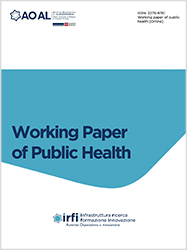Antimicrobial susceptibility of ESKAPE pathogens in the SS. Antonio e Biagio e Cesare Arrigo Hospital’s catchment area: December 2021 - July 2022

Accepted: 14 March 2023
All claims expressed in this article are solely those of the authors and do not necessarily represent those of their affiliated organizations, or those of the publisher, the editors and the reviewers. Any product that may be evaluated in this article or claim that may be made by its manufacturer is not guaranteed or endorsed by the publisher.
Background and Aims: this report describes the minimum inhibitory concentration distributions of the main drugs used against ESKAPE pathogens infection, recovered from patients treated between December 2021 and July 2022 at SS. Antonio e Biagio e Cesare Arrigo Hospital. Materials and Methods: data were extracted by a new Laboratory Information System implemented in mid-November 2021. Results: after exclusion of colonization: i) 56% of Enterococcus faecium was susceptible to teicoplanin and vancomycin; ii) 74% of Staphylococcus aureus was susceptible to methicillin; iii) 55.3% of Klebsiella pneumoniae was susceptible to cefotaxime, ceftazidime and cefepime and 93.2% of KPC was susceptible to ceftazidime/avibactam; iv) no Acinetobacter baumannii strains were resistant to colistin; v) 88.9% of Pseudomonas aeruginosa was susceptible to ceftolozane/tazobactam and 92.2% to ceftazidime/avibactam; vi) among Enterobacter species, 84.6% was susceptible to cefepime and 87.1% to ciprofloxacin. Conclusions: periodic reporting of local antibiotic resistance is an adjunctive tool to help the choice of antimicrobial therapy.
Antimicrobial Resistance Collaborators. Global burden of bacterial antimicrobial resistance in 2019: a systematic analysis. Lancet. 2022;399:629-55. DOI: https://doi.org/10.1016/S0140-6736(21)02724-0
Dadgostar P. Antimicrobial Resistance: Implications and Costs. Infect Drug Resist. 2019;12:3903-10. DOI: https://doi.org/10.2147/IDR.S234610
Ventola CL. The antibiotic resistance crisis: part 1: causes and threats. P T. 2015;40:277-83.
De Oliveira DMP, Forde BM, Kidd TJ, et al. Antimicrobial Resistance in ESKAPE Pathogens. Clin Microbiol Rev. 2020;33:e00181-19. DOI: https://doi.org/10.1128/CMR.00181-19
Hayes JF. Fighting Back against Antimicrobial Resistance with Comprehensive Policy and Education: A Narrative Review. Antibiotics (Basel). 2022;11:644. DOI: https://doi.org/10.3390/antibiotics11050644
European Antimicrobial Resistance Surveillance Network (EARS-Net). Available from: https://www.ecdc.europa.eu/en/publications-data/antimicrobial-resistance-eueea-ears-net-annual-epidemiological-report-2020
Cei M, Pardelli R, Sani S, Mumoli N. Local resistance patterns to antimicrobials in internal medicine: a focused report from the REGIMEN (REGistro Infezioni in MEdicina INterna) study. Clin Exp Med. 2014;14:77-82. DOI: https://doi.org/10.1007/s10238-012-0219-0
Elias C, Moja L, Mertz D, et al. Guideline recommendations and antimicrobial resistance: the need for a change. BMJ Open. 2017;7:e016264. DOI: https://doi.org/10.1136/bmjopen-2017-016264
The European Committee on Antimicrobial Susceptibility Testing. Breakpoint tables for interpretation of MICs and zone diameters. Version 11.0, 2021. Available from: http://www.eucast.org.
The European Committee on Antimicrobial Susceptibility Testing. Breakpoint tables for interpretation of MICs and zone diameters. Version 12.0, 2022. Available from: http://www.eucast.org.
Dayan GH, Mohamed N, Scully IL, et al. Staphylococcus aureus: the current state of disease, pathophysiology and strategies for prevention. Expert Rev Vaccines. 2016;15:1373-92. DOI: https://doi.org/10.1080/14760584.2016.1179583
Thwaites GE, Scarborough M, Szubert A, et al. United Kingdom Clinical Infection Research Group (UKCIRG). Adjunctive rifampicin for Staphylococcus aureus bacteraemia (ARREST): a multicentre, randomised, double-blind, placebo-controlled trial. Lancet. 2018;391:668-78. DOI: https://doi.org/10.1016/S0140-6736(17)32456-X
Zasowski EJ, Rybak JM, Rybak MJ. The β-Lactams Strike Back: Ceftazidime-Avibactam. Pharmacotherapy. 2015;35:755-70. DOI: https://doi.org/10.1002/phar.1622
Findlay J, Poirel L, Juhas M, Nordmann P. KPC-Mediated Resistance to Ceftazidime-Avibactam and Collateral Effects in Klebsiella pneumoniae. Antimicrob Agents Chemother. 2021;65:e0089021. DOI: https://doi.org/10.1128/AAC.00890-21
Breakpoints in brackets in breakpoint tables. Available from: https://www.eucast.org/fileadmin/src/media/PDFs/EUCAST_files/Guidance_documents/Breakpoints_in_brackets.pdf.
Jenkins A, Thomson AH, Brown NM, et al. Amikacin use and therapeutic drug monitoring in adults: do dose regimens and drug exposures affect either outcome or adverse events? A systematic review. J Antimicrob Chemother. 2016;71:2754-9. DOI: https://doi.org/10.1093/jac/dkw250
Aydin A, Ahmed K, Zaman I, et al. Recurrent urinary tract infections in women. Int Urogynecol J. 2015;26:795-804. DOI: https://doi.org/10.1007/s00192-014-2569-5
Liu Y, Lin Y, Wang Z, et al. Molecular Mechanisms of Colistin Resistance in Klebsiella pneumoniae in a Tertiary Care Teaching Hospital. Front Cell Infect Microbiol. 2021;11:673503. DOI: https://doi.org/10.3389/fcimb.2021.673503
Leli C, Di Matteo L, Gotta F, et al. Prevalence of Acinetobacter baumannii colonization and infection from 2011 to 2020 and comparison with the prevalence of SARS-CoV-2 in 2020 at the SS. Antonio e Biagio e Cesare Arrigo Hospital of Alessandria". Gimpios. 2021;11:17-21.
Lahiri SD, Walkup GK, Whiteaker JD, et al. Selection and molecular characterization of ceftazidime/avibactam-resistant mutants in Pseudomonas aeruginosa strains containing derepressed AmpC. J Antimicrob Chemother. 2015;70:1650-8. DOI: https://doi.org/10.1093/jac/dkv004
Chalhoub H, Sáenz Y, Nichols WW, et al. Loss of activity of ceftazidime-avibactam due to MexAB-OprM efflux and overproduction of AmpC cephalosporinase in Pseudomonas aeruginosa isolated from patients suffering from cystic fibrosis. Int J Antimicrob Agents. 2018;52:697-701. DOI: https://doi.org/10.1016/j.ijantimicag.2018.07.027
Expert Rules and Expected Phenotypes. Available from: https://www.eucast.org/expert_rules_and_expected_phenotypes/expected_phenotypes/.
Detection of Resistance Mechanisms. Available from: https://www.eucast.org/fileadmin/src/media/PDFs/EUCAST_files/Resistance_mechanisms/EUCAST_detection_of_resistance_mechanisms_170711.pdf.
Copyright (c) 2023 Christian Leli, Annalisa Roveta, Cesare Bolla, Andrea Rocchetti

This work is licensed under a Creative Commons Attribution-NonCommercial 4.0 International License.
PAGEPress has chosen to apply the Creative Commons Attribution NonCommercial 4.0 International License (CC BY-NC 4.0) to all manuscripts to be published.

 https://doi.org/10.4081/wpph.2023.9587
https://doi.org/10.4081/wpph.2023.9587




